Many gardeners prefer to grow fruiting plants in the apartment. Today, as indoor plants, you can see not only a lemon tree, but also decorative pepper. It looks spectacular and is a great addition to a variety of dishes. It has been popularly called the “light”, but in fact there are dozens of species and varieties of homemade pepper.
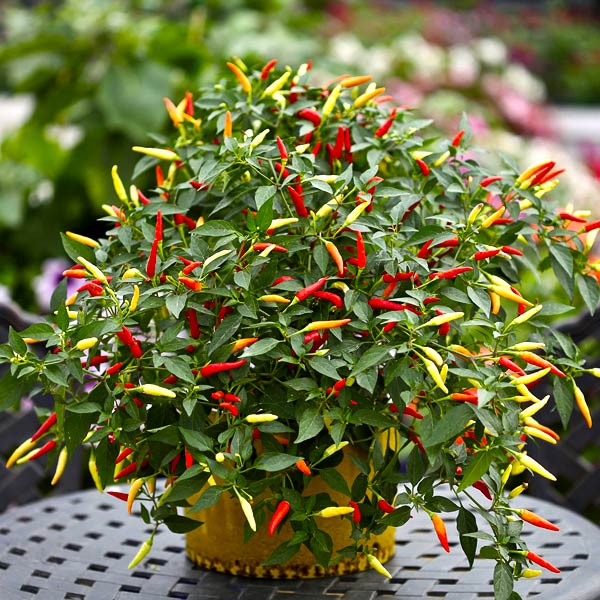
Exotic appearance, burning taste and ease of care in the usual home environment have made indoor pepper quite a popular culture.
Content
Description of indoor pepper and its types
Indoor pepper (capsicum) is a bright representative of the nightshade family. It grows well both in open soil and in a flowerpot in an apartment. This perennial can live in an apartment up to 5 years. The branching crown is covered with sharp, long or ovoid leaves, the color of which can be from light to dark green. Flowers are formed singly or in bunches. The color of the petals is most often white. The color and shape of the pods depends on the variety. Most varieties are characterized by abundant fruiting.

The most common is shrubby species, which for 5-6 years can live on the windowsill or loggia. The height of the bushes varies from 15 to 45 cm. Popular varieties: Spark, Bride, Queen of Spades, Carmen.
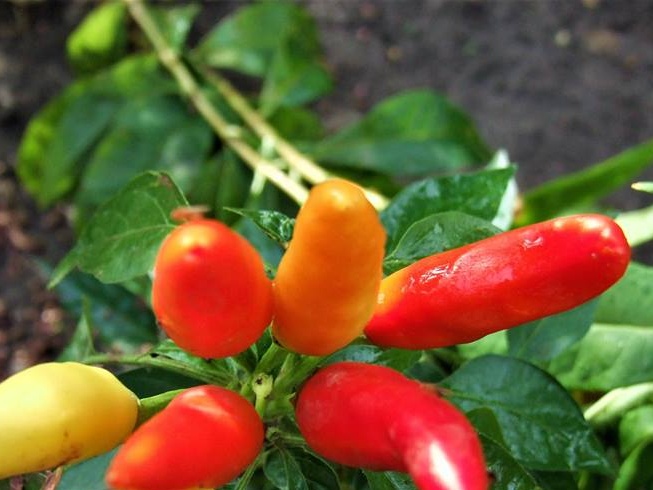
Berry (berry) peppers were named due to the flattened shape of the fruit, which looks like squash. Bushes grow to 80 cm. Pubescent varieties are often grown in open soil, but some (for example, Rokoto) bear fruit well in pots. The stems, leaves and even flowers of this pepper are covered with thick pubescence.
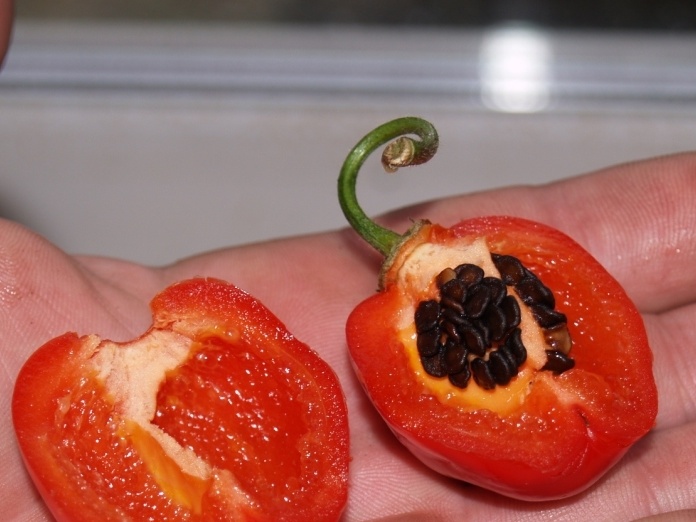
Among the variety, you should familiarize yourself with the most common homemade peppers.
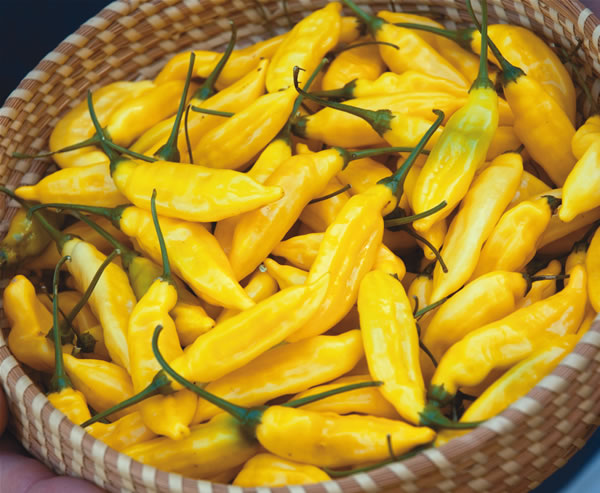 You may be interested in:
You may be interested in:Aladdin
The variety belongs to the earliest ripe peppers and is characterized by high productivity. The bush grows about 40 cm in height. The plant forms elongated fruits, which, as they ripen from a purple or off-white color, acquire a rich red color. Aladdin withstands the lack of lighting better than others, so it is often grown without the use of additional illumination. Due to the strong aroma, the fruits are used as a spice for preservation.
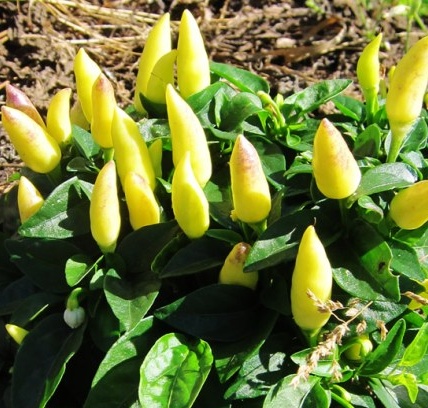
Twinkle
Spark - the most popular indoor pepper. It refers to mid-early varieties that ripen 115-120 days after germination. The elongated pod is painted in a deep red color and is characterized by a smooth skin. The medium-sized bush forms rather large fruits - about 45 g.
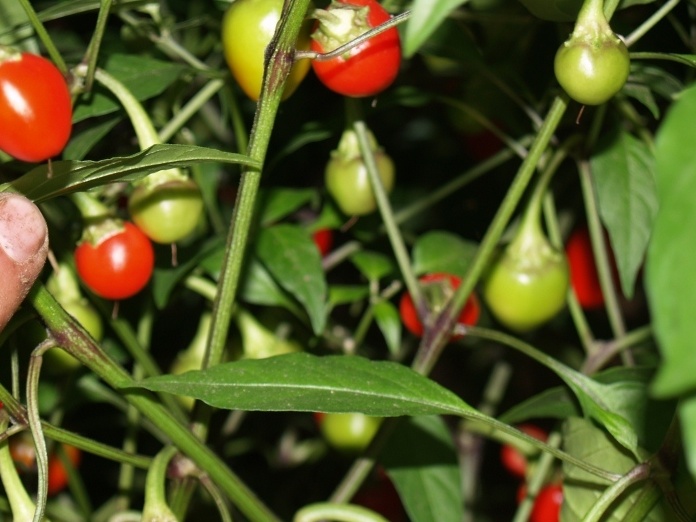
Nosegay
This pepper belongs to the smallest varieties, it can be grown even in a small room. Its height does not exceed 15 cm. A compact bush grows well in a container with a volume of about 1 liter. The fruits are very small; they look more like berries than vegetables.Their color depends on the stage of maturation, which is clearly visible in the photo: first green, whitish, orange, and then red. The pod has medium sharpness.
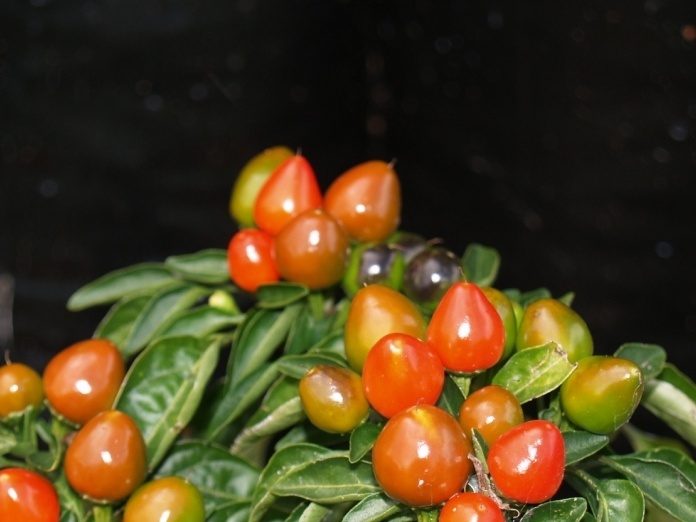
Explosive ember
The height of the branched bush does not exceed 35 cm. The variety is unpretentious and grows well in containers with a volume of 1 liter or more. Leaves, branches and stalks are painted in green-blue color. The color of the aboveground part depends on the intensity of lighting. If the plant is grown in the shade, then the color is predominantly blue, and if the sun is green. Ripe pods have a rich purple color.
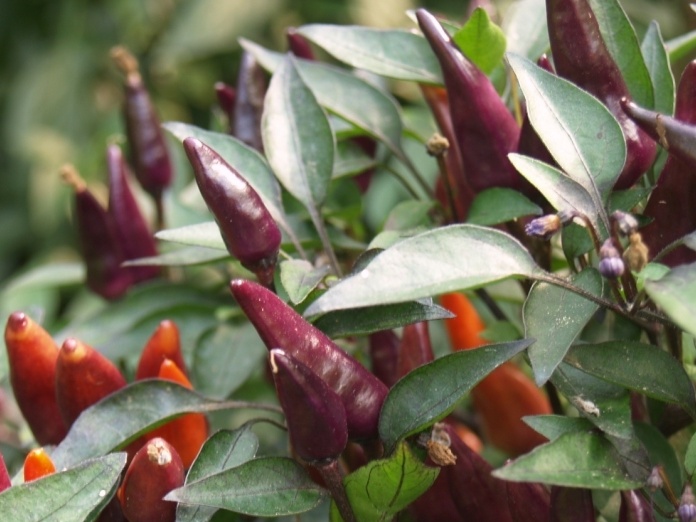
Growing decorative pepper in a pot and care at home
Growing a potted culture is a simple task for experienced vegetable growers, but for beginners, you should familiarize yourself with the rules and features of care.
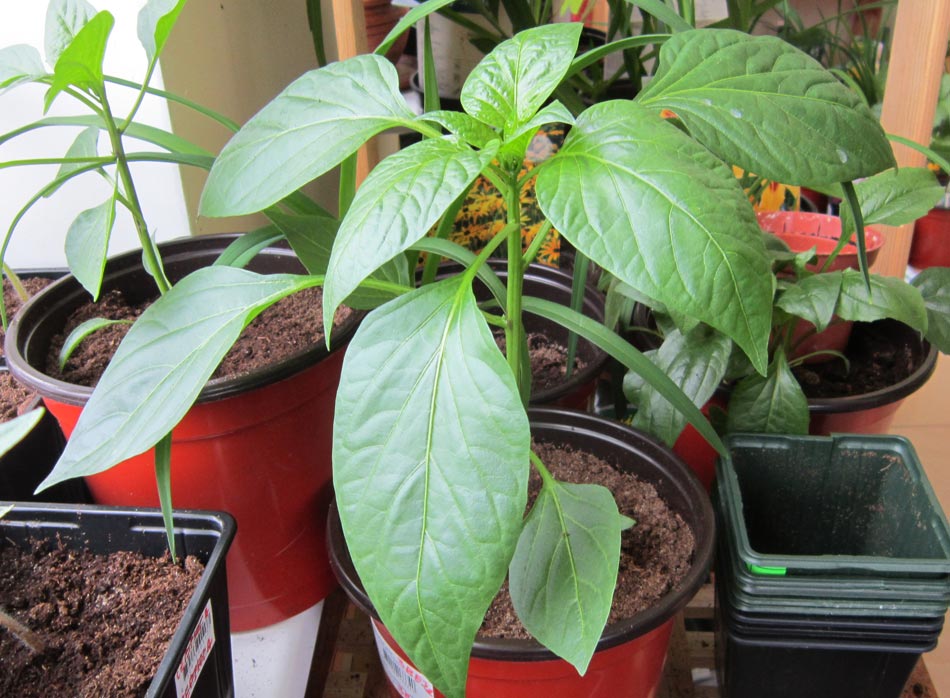 You may be interested in:
You may be interested in:Temperature and lighting for hot peppers
Like garden relatives, indoor varieties prefer a warm microclimate, so during the growing season they need to provide a temperature within 25 ° C. In winter, this figure should be slightly reduced to 15-18 ° C. Favorably affects the plant change in night and day temperatures. With the onset of heat, it is advised to transfer the pot to a balcony or loggia.
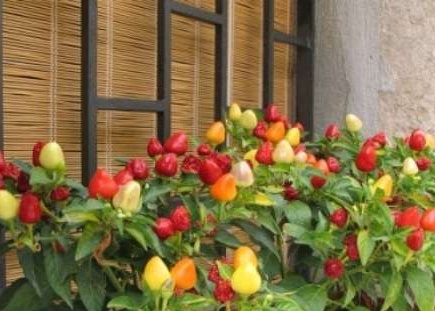
For full development and high productivity, it is advised to put a flowerpot on the western, southwestern or southern windowsill. The photophilous plant in spring and autumn needs good sunlight for up to 4 hours a day. On hot days, when the sun is especially active, the aerial part is best shaded. If there is too little light, use artificial lighting with phytolamps.
Watering and humidity
Pepper is a moisture-loving crop, so it is important to regularly monitor the condition of the soil and spray it to create the required level of moisture. For procedures, it is worth taking water at room temperature. In spring and summer, watering is carried out as the substrate dries, and spraying - at least twice a week.
With the onset of autumn, the frequency of irrigation is reduced, and in winter it is minimized. Pepper does not respond well to drought. Its leaves and fruits can not only wither, but also fall. A prolonged lack of water can lead to death.
Pot and substrate
The flowerpot for pepper should be small. If the plant dives from a common box, then the capacity should be no more than 100 ml. There must be drainage holes in the pot so that excess fluid can drain into the pan.
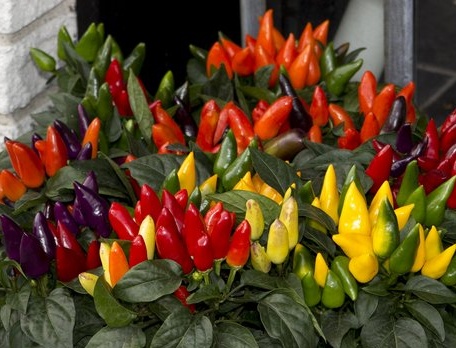
You can buy ready-made soil mix in the store, or you can make a nutrient substrate yourself:
- leaf humus - 2 parts;
- turf soil - 2 parts;
- sand - 1 part.
You can prepare the soil from the components that are found in any farm: crushed stone, sand, fertile black soil and universal fertilizer. All components are poured in layers. The first layer is crushed stone (drainage material), sand and black soil. Fertilizer can be mixed with soil or sprinkled between a layer of sand and earth.
Diseases and Pests
Like all indoor plants, capsicum can become ill or be attacked by insects. Sometimes the plant is attacked by aphids and spider mites, but this is a rare phenomenon, because it contains substances that repel insects.
If pests have appeared, then it is necessary to grind the pepper pod and pour it with water in a ratio of 1:10. Leave the product for 48 hours to insist, then add a little grated soap and mix thoroughly.The solution is sprayed with the aboveground part until the pests disappear.
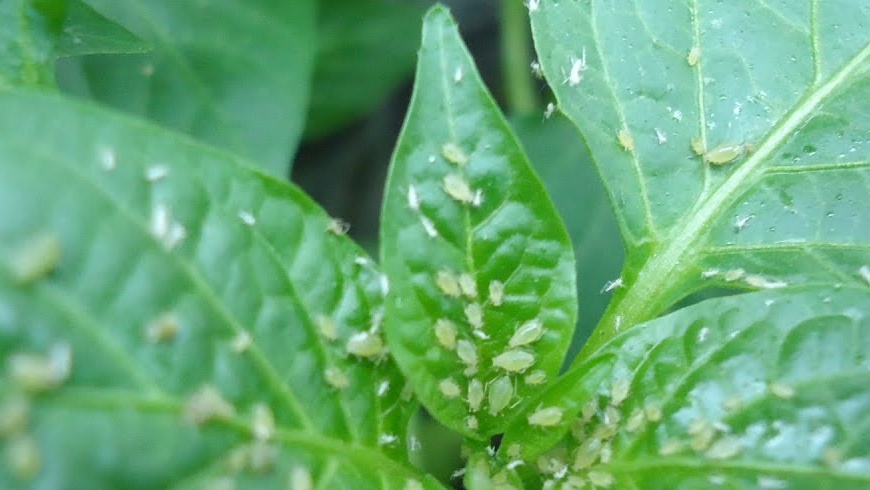
Diseases rarely affect decorative peppers, but the following problems often occur:
- the absence of flowering indicates an excess of nitrogen in the fertilizing;
- if the leaves change color or turn pale - most likely, the plant has little light. For the same reason, the bush can drop foliage.
If the watering is incorrect, root rot can be affected. To combat rot, it is worth adjusting watering, pruning damaged parts and moving to fresh soil. You can additionally treat the roots with a fungicide.
Propagation, planting and transplantation of indoor hot pepper
Ornamental culture is most often propagated by seed method, less often - by cuttings. Seeds are sown in February in two ways: the first is planting in a non-seedling and non-transplanting way, and the second is growing seedlings with further diving.
In the first method, you must immediately pick up a pot in which pepper will constantly grow. Its volume should be 4-6 liters. Planting material is soaked in water for 1 hour, after which it is laid out in a damp cloth and left for 24 hours. 2-4 mm seeds are buried in a container with fertile soil, the substrate is sprayed from the spray gun and covered with a bag.
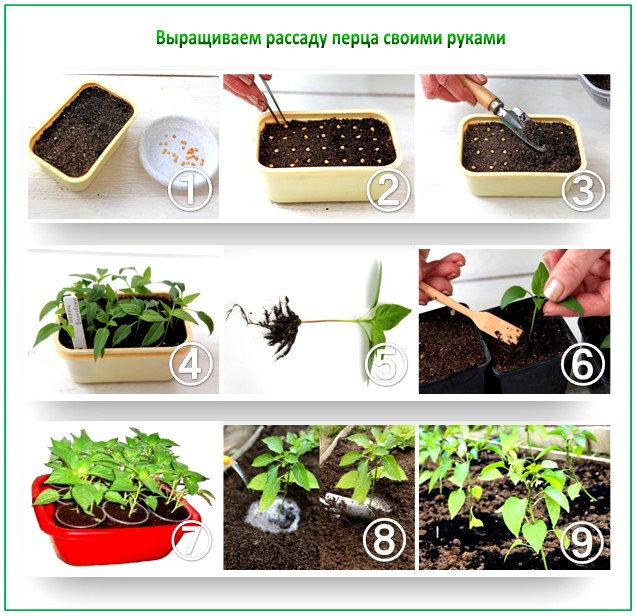
For the second method, the same manipulations with the seeds are carried out, only they need to be planted in a small container of about 200 ml. After the appearance of 4 leaves, the sprouts are transplanted and pinched. The transplantation is carried out by the method of transshipment of an earthen coma, so as not to damage the fragile roots. With any method of planting, it is important to first disinfect the soil by watering it with a weak solution of potassium permanganate.
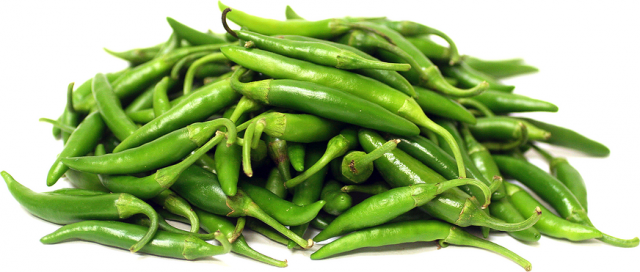 You may be interested in:
You may be interested in:Cuttings can propagate the plant during the period of active vegetation. To do this, cut the side stems and plant them in sandy-earth soil for rooting. Do not forget about good drainage, because after rooting the plant will live in the same container.
Common questions about growing hot peppers at home
Growing peppers in your own apartment is quite simple. It is perfect for those who do not like to wait long for the result, because it takes only 3-4 months from sowing seeds to harvesting. If you follow all the recommendations for care, you can get not only a bright plant, but also an excellent spice for preservation and pickles.




 Calorie pepper stuffed with meat and rice - BZHU per 100 grams
Calorie pepper stuffed with meat and rice - BZHU per 100 grams Gorky pepper - the best varieties for open ground
Gorky pepper - the best varieties for open ground Hot pepper seeds - the best varieties for open ground and reviews
Hot pepper seeds - the best varieties for open ground and reviews Capsicum tincture for hair - how to use and reviews
Capsicum tincture for hair - how to use and reviews